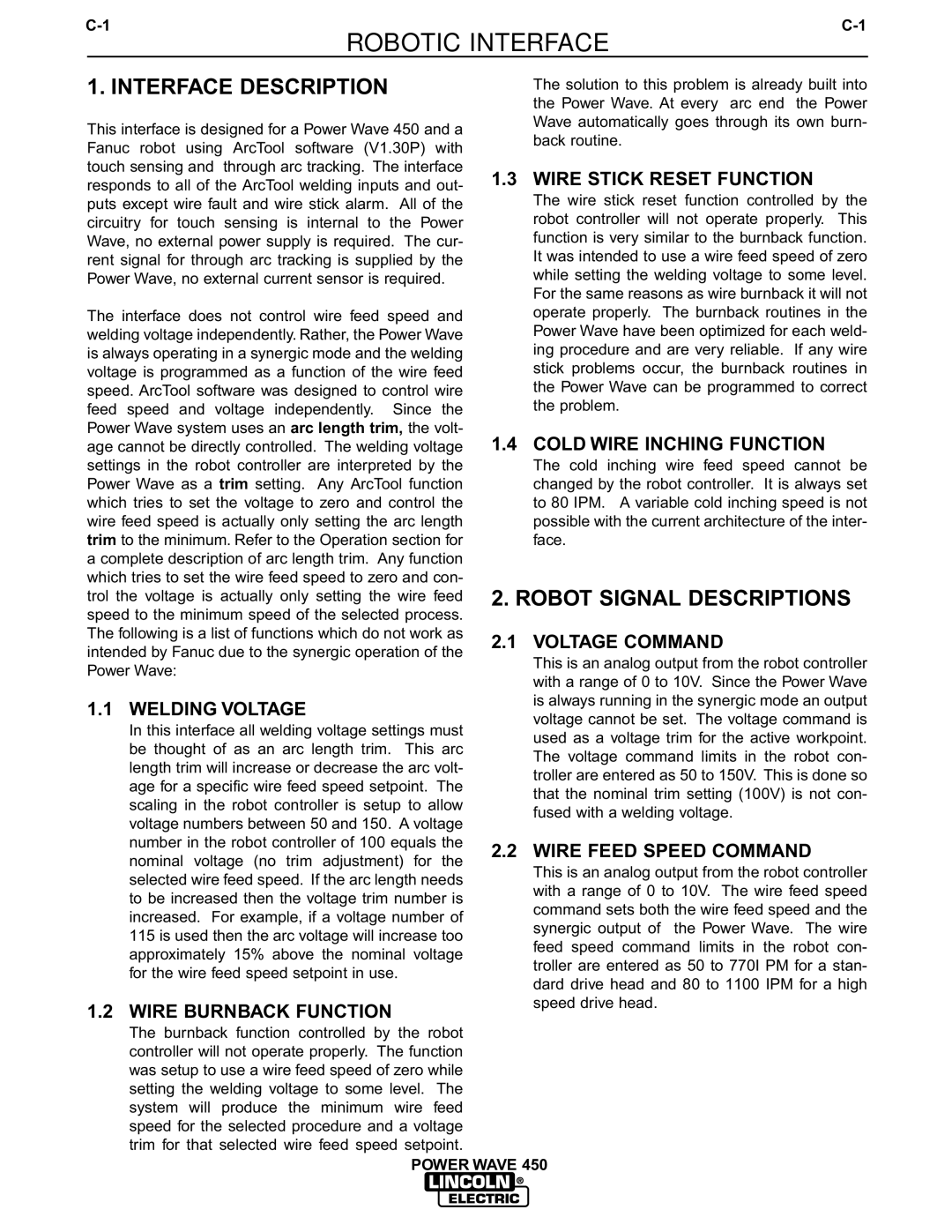
ROBOTIC INTERFACE
1. INTERFACE DESCRIPTION
This interface is designed for a Power Wave 450 and a Fanuc robot using ArcTool software (V1.30P) with touch sensing and through arc tracking. The interface responds to all of the ArcTool welding inputs and out- puts except wire fault and wire stick alarm. All of the circuitry for touch sensing is internal to the Power Wave, no external power supply is required. The cur- rent signal for through arc tracking is supplied by the Power Wave, no external current sensor is required.
The interface does not control wire feed speed and welding voltage independently. Rather, the Power Wave is always operating in a synergic mode and the welding voltage is programmed as a function of the wire feed speed. ArcTool software was designed to control wire feed speed and voltage independently. Since the Power Wave system uses an arc length trim, the volt- age cannot be directly controlled. The welding voltage settings in the robot controller are interpreted by the Power Wave as a trim setting. Any ArcTool function which tries to set the voltage to zero and control the wire feed speed is actually only setting the arc length trim to the minimum. Refer to the Operation section for a complete description of arc length trim. Any function which tries to set the wire feed speed to zero and con- trol the voltage is actually only setting the wire feed speed to the minimum speed of the selected process. The following is a list of functions which do not work as intended by Fanuc due to the synergic operation of the Power Wave:
1.1 WELDING VOLTAGE
In this interface all welding voltage settings must be thought of as an arc length trim. This arc length trim will increase or decrease the arc volt- age for a specific wire feed speed setpoint. The scaling in the robot controller is setup to allow voltage numbers between 50 and 150. A voltage number in the robot controller of 100 equals the nominal voltage (no trim adjustment) for the selected wire feed speed. If the arc length needs to be increased then the voltage trim number is increased. For example, if a voltage number of 115 is used then the arc voltage will increase too approximately 15% above the nominal voltage for the wire feed speed setpoint in use.
1.2 WIRE BURNBACK FUNCTION
The burnback function controlled by the robot controller will not operate properly. The function was setup to use a wire feed speed of zero while setting the welding voltage to some level. The system will produce the minimum wire feed speed for the selected procedure and a voltage trim for that selected wire feed speed setpoint.
The solution to this problem is already built into the Power Wave. At every “arc end” the Power Wave automatically goes through its own burn- back routine.
1.3 WIRE STICK RESET FUNCTION
The wire stick reset function controlled by the robot controller will not operate properly. This function is very similar to the burnback function. It was intended to use a wire feed speed of zero while setting the welding voltage to some level. For the same reasons as wire burnback it will not operate properly. The burnback routines in the Power Wave have been optimized for each weld- ing procedure and are very reliable. If any wire stick problems occur, the burnback routines in the Power Wave can be programmed to correct the problem.
1.4 COLD WIRE INCHING FUNCTION
The cold inching wire feed speed cannot be changed by the robot controller. It is always set to 80 IPM. A variable cold inching speed is not possible with the current architecture of the inter- face.
2. ROBOT SIGNAL DESCRIPTIONS
2.1 VOLTAGE COMMAND
This is an analog output from the robot controller with a range of 0 to 10V. Since the Power Wave is always running in the synergic mode an output voltage cannot be set. The voltage command is used as a voltage trim for the active workpoint. The voltage command limits in the robot con- troller are entered as 50 to 150V. This is done so that the nominal trim setting (100V) is not con- fused with a welding voltage.
2.2 WIRE FEED SPEED COMMAND
This is an analog output from the robot controller with a range of 0 to 10V. The wire feed speed command sets both the wire feed speed and the synergic output of the Power Wave. The wire feed speed command limits in the robot con- troller are entered as 50 to 770I PM for a stan- dard drive head and 80 to 1100 IPM for a high speed drive head.
